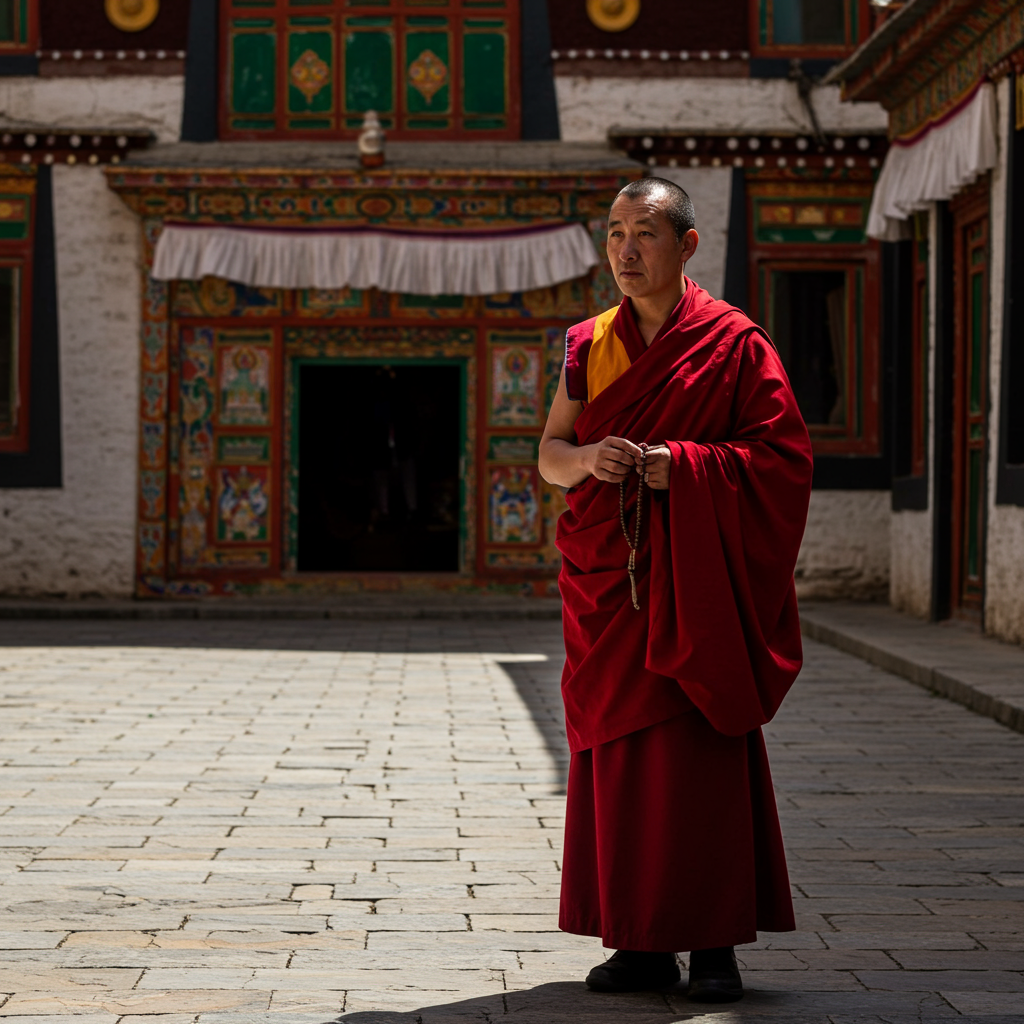Deep crimson robes flowed as the monk approached, prayer beads slipping through his fingers. A risky encounter in a land where speaking openly carries heavy consequences. Eight unidentified figures followed our every move. Even a brief public exchange could invite trouble. Yet, he chose to speak. “Things here are not good for us,” he stated quietly, a simple yet profound observation.
This monastery, nestled in southwest china‘s Sichuan province, has long stood as a symbol of <a href="https://news.quantosei.com/2025/07/02/dalai-lama-tightens-grip-on-reins-of-succession-in-the-face-of-chinese-pressure/” title=”Essential: Dalai Lama's Succession Plan Faces China Pressure”>tibetan defiance. Kirti monastery gained global attention in the late 2000s. It was here that Tibetans tragically set themselves alight, protesting Chinese rule. Nearly two decades later, Beijing remains wary of Kirti’s influence.
Pervasive Surveillance Casts a Shadow
The pervasive nature of state control is immediately apparent. A police station has been built right inside the monastery’s main entrance. It sits beside a small, dimly lit room filled with squeaking prayer wheels. Surveillance cameras perch on thick steel poles, nests watching every corner of the compound. “They do not have a good heart; everyone can see it,” the monk remarked, before offering a stark warning: “Be careful, people are watching you.” As our tails advanced, the monk turned and walked away into the silent Tibet.
“They” are the Communist Party of China. They have governed over six million Tibetans for nearly 75 years. This began when the region was annexed in 1950. China has invested heavily in Tibetan areas. They built new roads and railways. The stated goal is boosting tourism and integrating Tibet with the rest of the country. However, Tibetans who have fled report a different reality. They say economic development brought more troops and officials. This presence has chipped away at their faith and freedoms.
Beijing firmly views Tibet as an integral part of China. It labels the Dalai Lama, Tibet’s exiled spiritual leader, a dangerous separatist. Simply displaying his image or offering him public support can lead to imprisonment. Yet, some residents in Aba (Ngaba in Tibetan), where Kirti monastery is located, have taken extreme measures. They challenge these tight restrictions.
A Town Defined by Resistance and Loss
Aba lies outside the Tibet Autonomous Region (TAR). China created the TAR in 1965. It covers roughly half of the Tibetan plateau. Millions more Tibetans consider areas like Aba part of their homeland. Aba has historically been a focal point for resistance. Protests erupted here during the wider Tibetan uprising in 2008. Reports suggest a monk displayed a photo of the Dalai Lama inside Kirti monastery. This sparked events that escalated into a riot. Chinese troops opened fire. At least 18 Tibetans were killed in this small town.
Across Tibet, protests often turned into violent clashes with Chinese paramilitary forces. Beijing claimed 22 deaths in the 2008 uprising. Tibetan groups in exile estimated the number closer to 200. In the following years, Aba and surrounding areas witnessed over 150 self-immolations. These desperate acts protested Chinese rule and called for the Dalai Lama’s return. The main street tragically earned the moniker: Martyr’s row.
China’s crackdown has intensified since then. Obtaining information about events in Tibet or other Tibetan areas has become nearly impossible. The limited details that emerge often come from those who have escaped abroad. Information also comes from the Tibetan government-in-exile in India.
Seeking Voices Amidst the Silence
To learn more, we returned to Kirti monastery before dawn the next day. We managed to slip past our minders. We hiked back into Aba for the morning prayers. Monks gathered, their yellow hats a symbol of the Gelug school of Buddhism. Low, resonant chanting filled the hall. Ritual smoke hung in the still, humid air. Around 30 local men and women sat cross-legged. Most wore traditional Tibetan long-sleeved jackets. A small bell chimed, signaling the end of the prayer session.
Speaking cautiously, one monk shared his perspective. “The Chinese government has poisoned the air in Tibet,” he said. “It is not a good government.” He elaborated, “We Tibetans are denied basic human rights. The Chinese government continues to oppress and persecute us. It is not a government that serves the people.” He provided no specific examples. Our conversations remained brief, fearing detection. Hearing these voices directly is rare.
The Critical Question of Succession
The Dalai Lama turning 90 this week adds urgency to the question of Tibet’s future. Hundreds of his followers have gathered in Dharamshala, India, to honor him. He recently announced his much-anticipated succession plan. He reaffirmed his previous stance: the next Dalai Lama would be chosen after his death. Tibetans worldwide reacted with a mix of relief, doubt, and anxiety. Yet, in his homeland, a stark silence persists. Even whispering his name is forbidden.
Beijing has made its position unequivocally clear. The next reincarnation of the Dalai Lama will be found in China. That successor must be approved by the Chinese Communist Party. Tibet itself has offered no public reaction; it remains silent. “That’s just the way it is,” one monk told us. “That’s the reality.”
The road leading to Aba is a journey of nearly 500km (300 miles) from the Sichuan capital, Chengdu. It winds slowly through the snow-capped peaks of Siguniang Mountain. Eventually, it reaches the rolling grasslands at the edge of the Himalayan plateau. Golden temple rooftops shimmer every few miles. They catch the sharp sunlight on the “roof of the world.” Here, traffic yields to yak herders on horseback. They whistle to reluctant cattle as eagles circle overhead.
Two Worlds Collide Under the Himalayan Sky
Under this vast Himalayan sky, two worlds exist. Centuries of heritage and faith collide with the Party’s demand for unity and control. China maintains Tibetans are free to practice their faith. Yet, this faith is deeply intertwined with a centuries-old identity. Human rights groups argue Beijing is slowly eroding this identity. They claim countless Tibetans have been detained. Their offenses range from staging peaceful protests to promoting the Tibetan language. Possessing a portrait of the Dalai Lama can also lead to arrest.
Many Tibetans, including some monks at Kirti monastery, worry about new education laws. Children under 18 must now attend Chinese state-run schools. They must learn Mandarin. They cannot study Buddhist scriptures in monastery classes until they turn 18. Furthermore, they must pledge to “love the country and the religion.” They must also “follow national laws and regulations.” This represents a huge shift for communities. Traditionally, monks were often recruited as children. Monasteries often served as schools for most boys.
“One of the nearby Buddhist institutions was torn down by the government a few months ago,” a monk in his 60s shared in Aba. He spoke under an umbrella while walking to prayers in the rain. “It was a preaching school,” he added, visibly emotional. These new rules stem from a 2021 order. All schools in Tibetan areas, even kindergartens, must teach in Chinese. Beijing claims this improves job prospects in a Mandarin-speaking country.
Eroding Culture and Controlling Thought
Such regulations could have a “profound effect” on Tibetan Buddhism’s future. This is according to renowned scholar Robert Barnett. “We are moving to a scenario of the Chinese leader Xi Jinping having total control,” Mr. Barnett says. “Towards an era of little information getting into Tibet, little Tibetan language being shared.” He adds, “Schooling will almost entirely be about Chinese festivals, Chinese virtues, advanced Chinese traditional culture. We are looking at the complete management of intellectual input.”
The road to Aba showcases Beijing’s investment in this remote region. A new high-speed railway line hugs the hills. It connects Sichuan to other plateau provinces. In Aba town, traditional shops selling monks’ robes now sit alongside new hotels, cafes, and restaurants. These facilities cater to tourists. Chinese tourists arrive in branded hiking gear. They watch local faithful prostrate themselves on wooden blocks. They marvel at prayer wheels. “How do they get anything done all day?” one tourist wondered aloud.
A party slogan on the roadside boasts of ethnic unity. It claims “people of all ethnic groups are united as closely as seeds in a pomegranate.” Yet, the pervasive surveillance is difficult to ignore. Hotel check-ins require facial recognition. Buying petrol demands multiple forms of identification shown to high-definition cameras. China has long controlled citizen access to information. In Tibetan areas, this grip is significantly tighter. Tibetans, Mr. Barnett observes, are “locked off from the outside world.”
It’s hard to know how many Tibetans inside China learned of the Dalai Lama’s recent succession announcement. It was broadcast globally but censored internally. Living in exile since 1959, the 14th Dalai Lama has advocated for greater autonomy, not full independence. Beijing asserts he “has no right to represent the Tibetan people.” He transferred political authority in 2011. This went to a government-in-exile. It was democratically elected by 130,000 global Tibetans. That government reportedly held back-channel talks with China this year about succession. It is unclear if progress was made.
The Dalai Lama has suggested his successor would be from “the free world.” This means outside China. He recently stated, “no-one else has any authority to interfere.” This sets the stage for a potential confrontation with Beijing. China insists the process must follow religious rituals and historical customs. It must also be handled “in accordance with national laws and regulations.”
Competing Claimants and Cultural Control
Beijing is already laying the groundwork. It aims to convince Tibetans of its planned process. Mr. Barnett notes, “There is already a huge propaganda apparatus in place.” He adds, “The Party has been sending teams to offices, schools and villages to teach people about the ‘new regulations’ for choosing a Dalai Lama.” This strategy mirrors a past event. When the Panchen Lama died in 1989, the Dalai Lama identified a successor in Tibet. That child disappeared. Beijing was accused of kidnapping him. China insists the boy, now an adult, is safe. Beijing then approved a different Panchen Lama. Tibetans outside China do not recognize him.
If there were two Dalai Lamas, it would test China’s powers of persuasion. Which one would the international community recognize? Crucially, would most Tibetans in China even know of the other Dalai Lama? China desires a credible successor. However, perhaps not one who is too credible. Beijing, Mr. Barnett suggests, “wants to turn the lion of Tibetan culture into a poodle.”
“It wants to remove things it perceives as risky,” he explains. It seeks to replace them with state-approved concepts. These include patriotism, loyalty, and fealty. “They like the singing and dancing – the Disney version of Tibetan culture.” Mr. Barnett concludes, “We don’t know how much will survive.”
Resilience in the Face of Pressure
Leaving the monastery, a line of women passed through the prayer wheel room. They carried heavy baskets filled with tools. They were heading to construction or farming work. They sang in Tibetan and smiled as they walked past. Their greying, pleated hair was just visible under sun hats. Tibetans have clung to their identity for 75 years. They have fought for it and died for it.
The challenge now is to protect this identity. This is especially critical as the man embodying their beliefs and resistance approaches his final years.
Frequently Asked Questions
What is the current situation for Tibetans under Chinese rule?
Tibetans face significant state control and surveillance from the Chinese government. Pervasive monitoring, including cameras and police presence even inside monasteries like Kirti, is common. Basic human rights are reported to be denied, and freedom of expression is severely restricted. Displaying images of the Dalai Lama or voicing support for him can lead to harsh penalties, including imprisonment.
What is the significance of Kirti Monastery in Tibetan resistance?
Kirti Monastery in Aba, Sichuan, has been a historical epicenter of Tibetan resistance against Chinese rule. It was a focal point during the 2008 uprising and the site of numerous self-immolation protests in the years that followed, which tragically led to the area being known as “Martyr’s row.” The monastery remains a symbol of Tibetan identity and faith, despite intense surveillance and state interference.
Why is the Dalai Lama’s succession a point of conflict with China?
The succession of the Dalai Lama is a major point of contention. The current Dalai Lama wishes his successor to be chosen after his death, possibly from “the free world” outside China, and without external interference. In contrast, the Chinese Communist Party insists the reincarnation must be found within China and approved by the state, following “national laws and regulations.” This sets the stage for a potential scenario with two competing claimants, challenging traditional religious authority and international recognition.




